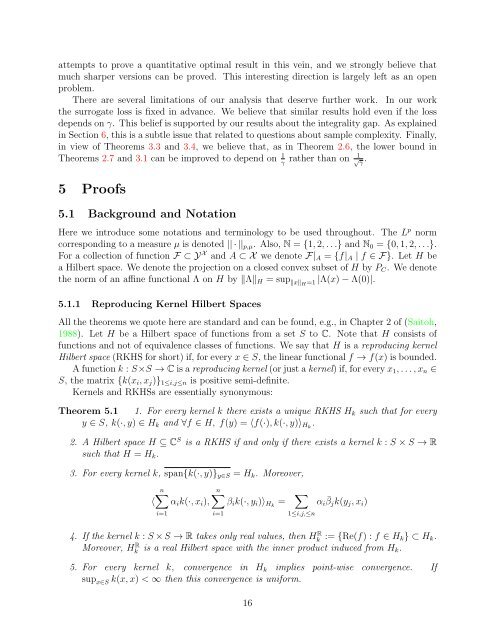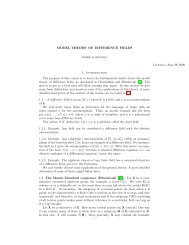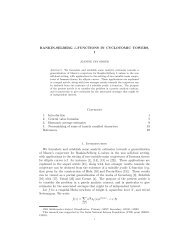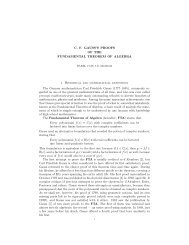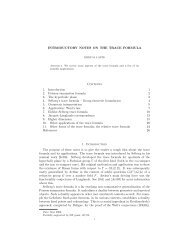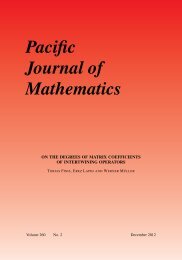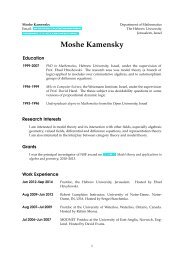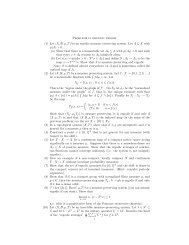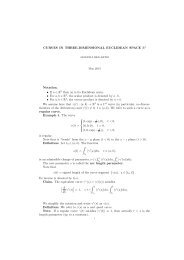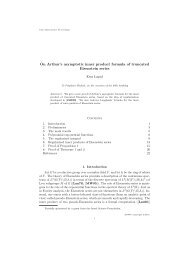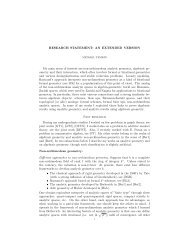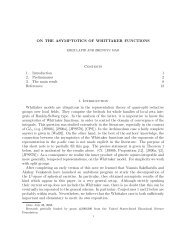The error rate of learning halfspaces using kernel-SVM
The error rate of learning halfspaces using kernel-SVM
The error rate of learning halfspaces using kernel-SVM
Create successful ePaper yourself
Turn your PDF publications into a flip-book with our unique Google optimized e-Paper software.
attempts to prove a quantitative optimal result in this vein, and we strongly believe thatmuch sharper versions can be proved. This interesting direction is largely left as an openproblem.<strong>The</strong>re are several limitations <strong>of</strong> our analysis that deserve further work. In our workthe surrogate loss is fixed in advance. We believe that similar results hold even if the lossdepends on γ. This belief is supported by our results about the integrality gap. As explainedin Section 6, this is a subtle issue that related to questions about sample complexity. Finally,in view <strong>of</strong> <strong>The</strong>orems 3.3 and 3.4, we believe that, as in <strong>The</strong>orem 2.6, the lower bound in<strong>The</strong>orems 2.7 and 3.1 can be improved to depend on 1 rather than on √1γ γ.5 Pro<strong>of</strong>s5.1 Background and NotationHere we introduce some notations and terminology to be used throughout. <strong>The</strong> L p normcorresponding to a measure µ is denoted || · || p,µ . Also, N = {1, 2, . . .} and N 0 = {0, 1, 2, . . .}.For a collection <strong>of</strong> function F ⊂ Y X and A ⊂ X we denote F| A = {f| A | f ∈ F}. Let H bea Hilbert space. We denote the projection on a closed convex subset <strong>of</strong> H by P C . We denotethe norm <strong>of</strong> an affine functional Λ on H by ‖Λ‖ H = sup ‖x‖H =1 |Λ(x) − Λ(0)|.5.1.1 Reproducing Kernel Hilbert SpacesAll the theorems we quote here are standard and can be found, e.g., in Chapter 2 <strong>of</strong> (Saitoh,1988). Let H be a Hilbert space <strong>of</strong> functions from a set S to C. Note that H consists <strong>of</strong>functions and not <strong>of</strong> equivalence classes <strong>of</strong> functions. We say that H is a reproducing <strong>kernel</strong>Hilbert space (RKHS for short) if, for every x ∈ S, the linear functional f → f(x) is bounded.A function k : S×S → C is a reproducing <strong>kernel</strong> (or just a <strong>kernel</strong>) if, for every x 1 , . . . , x n ∈S, the matrix {k(x i , x j )} 1≤i,j≤n is positive semi-definite.Kernels and RKHSs are essentially synonymous:<strong>The</strong>orem 5.1 1. For every <strong>kernel</strong> k there exists a unique RKHS H k such that for everyy ∈ S, k(·, y) ∈ H k and ∀f ∈ H, f(y) = 〈f(·), k(·, y)〉 Hk .2. A Hilbert space H ⊆ C S is a RKHS if and only if there exists a <strong>kernel</strong> k : S × S → Rsuch that H = H k .3. For every <strong>kernel</strong> k, span{k(·, y)} y∈S = H k . Moreover,〈n∑α i k(·, x i ),i=1n∑β i k(·, y i )〉 Hk =i=1∑1≤i,j,≤nα i ¯βj k(y j , x i )4. If the <strong>kernel</strong> k : S × S → R takes only real values, then H R k := {Re(f) : f ∈ H k} ⊂ H k .Moreover, H R k is a real Hilbert space with the inner product induced from H k.5. For every <strong>kernel</strong> k, convergence in H k implies point-wise convergence. Ifsup x∈S k(x, x) < ∞ then this convergence is uniform.16


